(Written by William)
In this Brick Breakdown series, I review official LEGO sets from the perspective of finding interesting building techniques that we can learn from. Today we will be examining the recently released #71042 LEGO Pirates of the Caribbean Silent Mary. But before we begin, let me give you some overall impressions I had while building the set (and you can also check out a full review here: Pirates of the Caribbean Silent Mary Review). 🙂

I have to say that the LEGO Pirates of the Caribbean Silent Mary is both my most favorite and least favorite LEGO ship of all time. This is primarily because of how it compares to other ships LEGO released in the past. On the one hand, it is probably the most detailed model I’ve ever seen; the broken hull and dilapidated appearance are marvels in and of themselves. On the other hand, the play-features are significantly lacking. The dropping of the sharks, the gaping front, and the collapsing mast are okay and accurate to the film, but the entire inside of the ship is inaccessible and unusable. Why is there no captain’s cabin, jail cell, or at least some kind of very basic interior? LEGO is pretty good at adding a reasonable amount of playability even to their display sets, but here there is not much you can do.
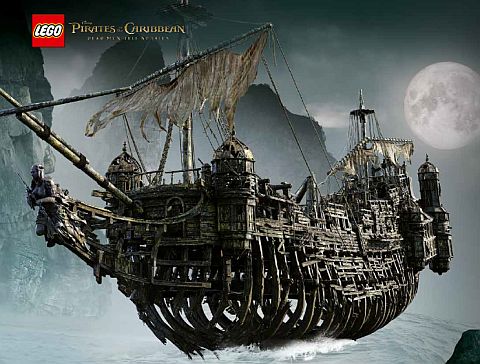
To give you some comparisons, the LEGO Pirates of the Caribbean Silent Mary is 2,294 pieces and retails for $200. Two similar size sets are the #10210 LEGO Imperial Flagship from 2010 (1,664 pieces, $180), and the #70810 LEGO Movie MetalBeard’s Sea Cow from 2014 (2,741 pieces, $250) – both of which got the balance between displayability and play-value just right. With the Silent Mary, you get a magnificent sculpture of a dilapidated pirate ship, but don’t expect it to be anything like other ships LEGO previously released.
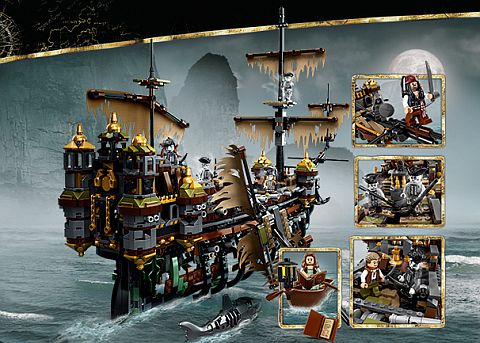
If you can get past comparing the set to standard LEGO pirate ships, and you are clear on what you are getting into, you will start to appreciate the Silent Mary for its unique features. LEGO has given us slightly tattered ships before, like the #7029 LEGO Castle Fantasy Era Skeleton Ship Attack from 2007. We have even gotten shipwrecks like the #60095 LEGO City Deep Sea Exploration Vessel from 2015, and haunted ships like the one in the #70732 LEGO Ninjago City of Stiix from 2015. However, they are all play-sets, and on the smaller side. Then, we have the Silent Mary; a full-blown, fully detailed, fully debilitated shipwreck… that is also haunted. The set may not please everyone, but in many ways, it is extraordinary. And it’s also full of interesting building techniques.

➡ OVERLAPPING SUPERSTRUCTURE WITH LEGO
Most large and complex LEGO sets start out with a solid LEGO Technic framework that will support the rest of the structure. But what do you do when the frame you want to build doesn’t follow straight lines? The LEGO Pirates of the Caribbean Silent Mary solves this problem by overlapping the superstructure. The first layer is used to create general stability, and the second layer’s job is to define the shape. For this reason, the lower level is smaller, so it doesn’t get in the way of the shaping. It’s important to do the steps in this order, otherwise you can lose stability as you are trying to make unusual shapes.
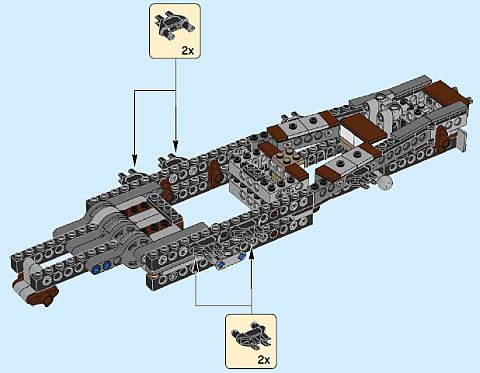
If you want your superstructure to have a certain function, like hinging, you will approach the situation slightly differently. First, you find a section that can handle the strain you plan to place on the superstructure. This could include solutions like a larger surface area, or specific type of resistance the selected section can provide. Once the section has been selected, you need to overlap the structure until it holds up to what you want to accomplish. In the case of the Silent Mary, the goal is for the locking hinge to hold the weight of the bow of the ship without clicking to a different angle.
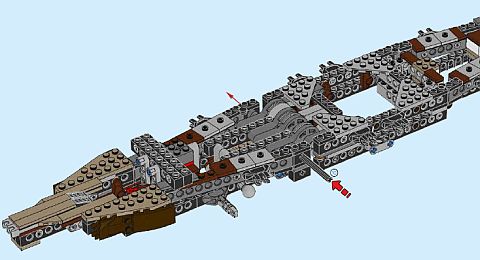
➡ SYMMETRICAL ASYMMETRY WITH LEGO
Building large structures out of LEGO bricks is already full challenges. And, if one of your design goals is to make your model look asymmetric, so it appears naturally formed (or deformed), it is another challenge you need to deal with. You can spend a lot of time fiddling with details to achieve an asymmetric look, but the Silent Mary provides a quicker and easier solution.
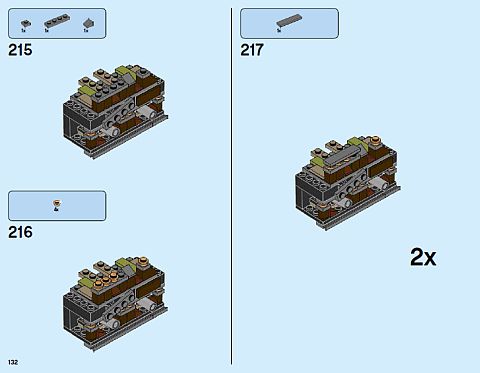
Start with a section that requires roughly the same look on opposite sides. In the Silent Mary, a good example is the stern of the ship. Now, you build the two sides exactly the same, including the placement of the imperfections. How you are going to make them look asymmetrical is by their orientation to each other. Simply put them at opposite sides of the model, so now the imperfections are not compared to one another, but rather the model as a whole. The only rule of thumb to follow is to avoid putting sections like these on the same side, which would make it easier to spot the direct comparisons.
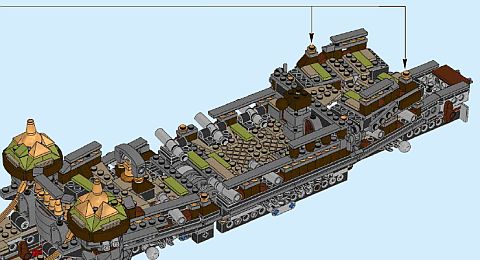
➡ DRAPING WITH LEGO
Before we get to the actual draping technique, let’s look at why you may need to use such a method. The image below shows the underlying supports of the Silent Mary. You can see there is little to connect to, aside from the LEGO Technic portions. If you are building a ship that needs to have some major holes (shipwreck, ghost ship, battle damage, etc.), you need all the empty space you can get to achieve the right look. And this gives us a good reason to look at draping.
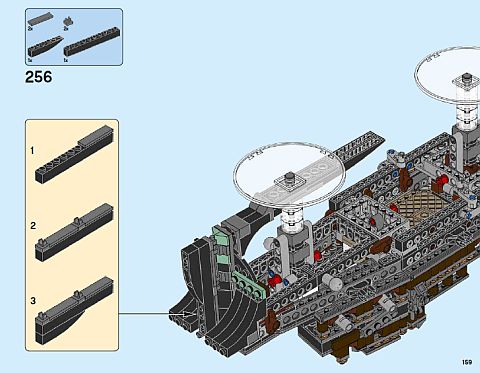
Draping is essentially making a section just hang over the space it needs to cover. In other words, it drapes over the area like a curtain or tablecloth. As you can tell by looking at the Silent Mary, what you drape does not have to be plain in any sense of the imagination. The draped hull used here contains cannons and other details, along with curved sections of the hull. It is a very expressive bit of ornamentation that is only skin-deep. Granted, this technique does not lend itself to strong and stable models, however as long as the structural foundation is solid, it can provide a very interesting option.
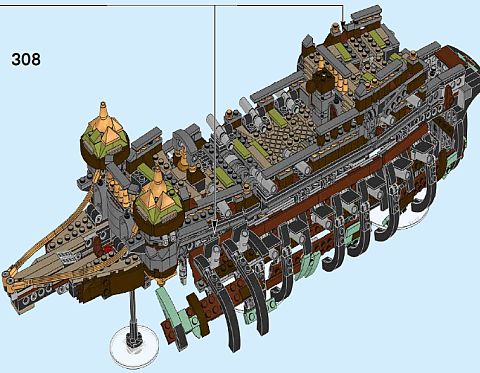
➡ APPLYING WHAT YOU LEARN
LEGO models will live and die by how solidly they are built. The more challenging designs you attempt, the more you will be forced to find new ways to accomplish what originally you thought was impossible. Seeing and understanding how parts of a structure are layered and can serve different functions, will go a long way in your mastery of large models.
Some may call it cheating, but a great LEGO builder knows when and how to take shortcuts. Using identical sections to form asymmetric designs is one such shortcut that can not only help you accomplish what you want, but can save you time in the process.
Draping may not be your first choice to add finishing touches to your LEGO project, but it can be an interesting and effective solution, especially when you need to make your model appear damaged or hollow inside. It could also be used for making hidden passageways, or add additional details without standard connection points. It’s something you should keep in mind when you are dealing with interesting projects with unusual shapes.

What do you think? How do you like the LEGO Pirates of the Caribbean Silent Mary? And what do you think of the building techniques we discussed here? Do you have the set already? Have you noticed any other interesting details or building solutions? Feel free to share your thoughts and own review in the comment section below! 😉
And you might also like to check out the following related posts:












This is a very bold set from Lego. Yes, it is not a traditional pirate ship, but once you can get over that fact, there is so much here! It is also a great parts pack and the techniques are so interesting! I hope it sells well so Lego will continue to make unusual sets like this.
I agree that it’s nice to see interesting sets like these that are out of the norm. The big question, of course, is going to be how many people are going to buy it. If it is popular, I’m sure LEGO will make more. If not, they will likely go back to more traditional/safer sets.
Very interesting to look at this set from the perspective of techniques. The overlapping and draping techniques are something you usually see from afols, not from the company. I don’t know if I would want to have this ship on display, but I would sure like to build it just for the experience.
Yeah, this set is definitely more interesting from the perspective of building techniques rather than playability. Maybe even the display value. Official LEGO sets, especially the large ones, are an excellent way to learn interesting techniques. It’s worth taking the time to study them, rather than just focusing on finishing the build.
Those are some neat techniques; I don’t believe I’ve heard of the overlapping one before. I think a lot of larger LEGO sets use a modified version of that, where a sturdy Technic frame is built, but the next layer is composed of plates to form the shape rather than another layer of Technic bricks. I feel like the draped sections are one of the reasons people think the set is unstable, even if they don’t support the ship at all. But I think they do create the destroyed hull effect quite well.
On the lack of functions on the ship, the stability of the many fiddly details on the back would be compromised by an interior, and such an interior would likely be too small and inaccessible to include much inside. As a ship, there’s not much playability in the first place, besides it sliding around; hence the mast and hinging front are remarkable functions. The only way I see to add playability would be to replace the cannons with stud shooters, and I do wonder how AFOLs would have reacted if those came on the set.
Also, a minor note: In the article’s third and fourth paragraphs, I don’t think the word “debilitated” fits very well; “dilapidated” is more accurate. 🙂
LOL! Yeah, stud-shooters would have made AFOLs mad! Thank for catching that typo. I’m so impatient with editing, so always appreciate your help. 🙂
That’s an excellent and very interesting topic.
I’m now very impatient to get this ship to see in detail all those techniques.
There are sometimes some good draping techniques for the roofs of the big buildings because that’s the last thing to do and we have to close it; i’m thinking to the Parisian restaurant or some buildings of the winter village sets. We add sections to make the roof, i don’t know if i’m clear 🙂
Anyway thanks for this article.
Oh, yes, the Parisian has a very interesting roof that I guess you could call draping. The thing about it though that with the Parisian the drape is closed in at both top and bottom, whereas here the drape truly hangs like a tablecloth.